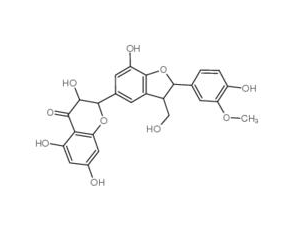
Silychristin
CAS No. 33889-69-9
Silychristin( —— )
Catalog No. M18438 CAS No. 33889-69-9
Silychristin is a plant growth regulator. Silychristin is an anti-hepatotoxic agent. Silychristin is the inhibitor of horseradish peroxidases and lipoxygenase.
Purity : >98% (HPLC)
 COA
COA
 Datasheet
Datasheet
 HNMR
HNMR
 HPLC
HPLC
 MSDS
MSDS
 Handing Instructions
Handing Instructions
| Size | Price / USD | Stock | Quantity |
| 5MG | 63 | In Stock |


|
| 10MG | 88 | In Stock |


|
| 25MG | 155 | In Stock |


|
| 50MG | 230 | In Stock |


|
| 100MG | 340 | In Stock |


|
| 200MG | Get Quote | In Stock |


|
| 500MG | Get Quote | In Stock |


|
| 1G | Get Quote | In Stock |


|
Biological Information
-
Product NameSilychristin
-
NoteResearch use only, not for human use.
-
Brief DescriptionSilychristin is a plant growth regulator. Silychristin is an anti-hepatotoxic agent. Silychristin is the inhibitor of horseradish peroxidases and lipoxygenase.
-
DescriptionSilychristin is a plant growth regulator. Silychristin is an anti-hepatotoxic agent. Silychristin is the inhibitor of horseradish peroxidases and lipoxygenase.
-
In VitroSilychristin exhibits a strong inhibition of MCT8-mediated T3 uptake with an IC50 of 110 nM in MCT8 overexpressing MDCK1-cells.Silychristin causes no cytotoxic for fibroblasts.Silychristin (6.5-75 μM; 24 hours) diminishes UVA toxicity and reduces ROS generation, and the protective effect is dose-dependent.Silychristin (12.5μM, 25μM) reduces the metalloproteinase-1 (MMP-1) level in cells. Cell Viability Assay Cell Line:NHDF Concentration: 6.5 μM,12.5 μM,25 μM,50 μM,75 μM Incubation Time:24 hours Result:Diminished UVA toxicity and reduced ROS generation in dose-dependent.Cell Viability Assay Cell Line:NHDF Concentration:12.5 μM, 25 μM Incubation Time: Result:Reduced the metalloproteinase-1 (MMP-1) level in cells.
-
In Vivo——
-
Synonyms——
-
PathwayOthers
-
TargetOther Targets
-
Recptor5-Lipoxygenase
-
Research AreaOthers-Field
-
Indication——
Chemical Information
-
CAS Number33889-69-9
-
Formula Weight482.44
-
Molecular FormulaC25H22O10
-
Purity>98% (HPLC)
-
SolubilityIn Vitro:?DMSO : 100 mg/mL (207.28 mM)
-
SMILESCOc1cc(ccc1O)[C@@H]1Oc2c(cc(cc2O)[C@H]2Oc3cc(O)cc(O)c3C(=O)[C@@H]2O)[C@H]1CO
-
Chemical Name——
Shipping & Storage Information
-
Storage(-20℃)
-
ShippingWith Ice Pack
-
Stability≥ 2 years
Reference
1. Vav?íková E, et al. Regioselective Alcoholysis of Silychristin Acetates Catalyzed by Lipases[J]. International Journal of Molecular Sciences, 2015, 16(6):11983-11995.
molnova catalog



related products
-
Mesosulfuron-methyl
Mesosulfuron-methyl is a systemic herbicide. It is used for post-emergence control of grasses and other weeds in cereals.
-
SW157765
SW157765 is a selective glucose transporter GLUT8 (SLC2A8) inhibitor, a prodrug of many compounds, that selectively inhibits the uptake of fluorescent 2-deoxyglucose (2DG) in SW157765-sensitive cells in a dose-dependent manner, and can be used for the study of lung cancer.
-
Dalbavancin Impurity
Dalbavancin is a semisynthetic lipoglycopeptide that was designed to improve upon the natural glycopeptides currently available, vancomycin and teicoplanin.



 Cart
Cart
 sales@molnova.com
sales@molnova.com


